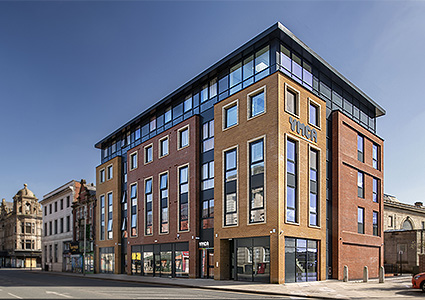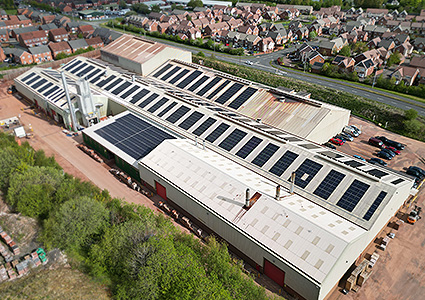Learn about the process behind Michelmersh’s hydrogen-fueled innovation, Hybrick
With the primary ambition of being a financially sound, sustainable, and environmentally responsible company, Michelmersh Brick Holdings Plc (Michelmersh) is dedicated to delivering top-class products. Not only does Michelmersh stand as one of the UK’s leading brick specialists, but it is also a key manufacturer of traditional hand-pressed architectural terracotta and a highly regarded clay brick producer in Europe. Sarah Le Gresley, Group Innovation Director, provides an up-to-date account of the company’s endeavors over the last couple of years.
 “Acquisitions have organically fueled our growth, enabling us to manufacture approximately 120 million bricks annually,” she opens. “Since our last interview with Manufacturing Today in 2022, we have purchased the largest independent prefabrication maker of brick components in the UK. These components, including special shaped bricks, are widely used to construct building arches, lintels, façade systems, and chimneys. Additionally, this strategic acquisition has provided us with expertise in precision cutting and bonding techniques. Presently, we operate five manufacturing facilities across the UK and one in Belgium. Along with that, we have four prefabrication sites that we are steadily integrating into our business and brickwork site. This comprehensive infrastructure is complemented by our bespoke firing services and architectural terracotta offerings. Hence, we cater to a wider market range, providing more diverse options than standard clay bricks and pavers.
“Acquisitions have organically fueled our growth, enabling us to manufacture approximately 120 million bricks annually,” she opens. “Since our last interview with Manufacturing Today in 2022, we have purchased the largest independent prefabrication maker of brick components in the UK. These components, including special shaped bricks, are widely used to construct building arches, lintels, façade systems, and chimneys. Additionally, this strategic acquisition has provided us with expertise in precision cutting and bonding techniques. Presently, we operate five manufacturing facilities across the UK and one in Belgium. Along with that, we have four prefabrication sites that we are steadily integrating into our business and brickwork site. This comprehensive infrastructure is complemented by our bespoke firing services and architectural terracotta offerings. Hence, we cater to a wider market range, providing more diverse options than standard clay bricks and pavers.
“As a specialized brick supplier, we are equipped to serve not only the specification market, but also a variety of others including the high-end luxury house building and large-scale volume sectors. Our product range caters to both premium and non-premium segments. Notably, our products have been utilized in prestigious projects such as Battersea Power Station, ITV studios, Harrods, as well as in public establishments like universities and hospitals up and down the country. Thanks to this versatility, we boast a strong presence in different markets and can cater to a broader range of clients,” she adds.
One of Michelmersh’s most important recent contributions to the industry is its revolutionary Hybrick, which is currently on display at the Science Museum exhibition. Together with Michael (Mick) Brophy, Group Production Director, Sarah tells us more about the process behind this sustainable innovation. “Mick and I collaborated closely with numerous specialists to realize our idea of decarbonizing the brick making process. To do so, we explored alternatives to natural gas and successfully secured the world’s first testing trial thanks to government funding. Collaborating with local suppliers, we obtained a sufficient supply of green hydrogen to meet the trial’s scale requirements. In short, the trial was a success and resulted in a substantial reduction of 81-to-84 percent of carbon emissions compared to natural gas during the firing process. This is an incredible achievement for us, especially considering that we are a small manufacturer representing only six percent of the market. Furthermore, the trial demonstrated the potential future of brick making to the rest of the industry, emphasizing our capability to manufacture low carbon products,” she begins.
Comprising three different attempts, the trial was not achieved without any challenges, as Mick reveals: “During the trial, the main difficulty we encountered revolved around preparing the equipment and working with hydrogen, which presented a distinct set of regulations, safety considerations, and control requirements. In contrast, the firing process itself was relatively easy since we were already familiar with it. Along with our partners, we spent a substantial amount of time complying with all necessary regulations before proceeding with lighting the hydrogen and starting the firing process. Our objective was to replicate the firing cycle typically used with natural gas, while utilizing the required equipment for hydrogen. Once we achieved that, we conducted three firings, aiming to replicate the same firing profile as with natural gas.
revolved around preparing the equipment and working with hydrogen, which presented a distinct set of regulations, safety considerations, and control requirements. In contrast, the firing process itself was relatively easy since we were already familiar with it. Along with our partners, we spent a substantial amount of time complying with all necessary regulations before proceeding with lighting the hydrogen and starting the firing process. Our objective was to replicate the firing cycle typically used with natural gas, while utilizing the required equipment for hydrogen. Once we achieved that, we conducted three firings, aiming to replicate the same firing profile as with natural gas.
“The first burn resulted in variations in size and color, prompting us to make necessary adjustments. Indeed, hydrogen’s high velocity and pressure of 300 bar makes it harder to control than natural gas. To overcome this, we reduced the pressure to three bar at the burner head, changed the gas-air ratios, and adjusted the way the bricks were arranged to allow for better airflow. Although the initial two attempts presented difficulties, they still produced a brick that was hard enough to be physically handled. However, the adjustments made throughout the trial led to the third and final firing proving extremely successful. Subsequently, we subjected the brick to independent and internal testing, documenting its size, compressive strength, and other relevant aspects. Michelmersh is exceptionally proud of the trial’s outcomes, which effectively demonstrated our ability to utilize 100 percent hydrogen within our standard manufacturing process for firing clay brick products,” he enthusiastically explains.
As our conversation draws to a close, Mick highlights the company’s focus on energy efficiency, as evidenced by its ongoing investment program for capital expenditures. “We have implemented a kiln scrubber system that effectively cleans our emissions, which is beneficial for our manufacturing process as well as the environment. Additionally, we are investing in solar energy for certain sites, such as our Telford factory. Besides, we are focused on water reduction, emphasizing the importance of water processing and recycling across various facilities. To enhance our operations, we are upgrading our brick-making equipment by replacing outdated machinery with modern efficient components, including electronic systems and processing equipment that contribute to the reduction of noise, heat, and various other factors.”
Lastly, Sarah notes Michelmersh’s focus on decarbonization. “We strive to use less raw materials, transition our fleets to alternative fuels and investigate alternative and innovative ways to manufacture clay products as part of our road map to decarbonize towards a net zero goal,” she ends.
